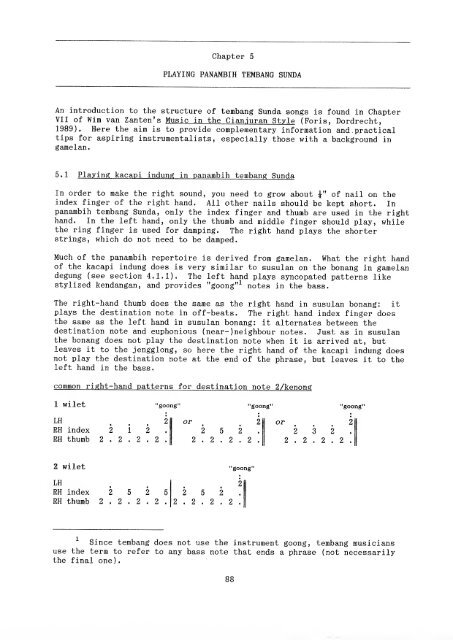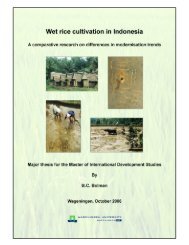Guide to Sundanese Music - Free EBooks Library
Guide to Sundanese Music - Free EBooks Library
Guide to Sundanese Music - Free EBooks Library
Create successful ePaper yourself
Turn your PDF publications into a flip-book with our unique Google optimized e-Paper software.
Chapter 5<br />
PLAYING PANAMBIH TEMBANG SUNDA<br />
An introduction <strong>to</strong> the structure of tembang Sunda songs is found in Chapter<br />
VII of ffim van Zanten's <strong>Music</strong> in the Cian.iuran Style (Foris, Dordrecht,<br />
1989). Here the aim is <strong>to</strong> provide complementary information and practical<br />
tips for aspiring instrumentalists, especially those with a background in<br />
game Ian.<br />
5*1 Playing kacapi indung in panambih tembang Sunda<br />
In order <strong>to</strong> make the right sound, you need <strong>to</strong> grow about i" of nail on the<br />
index finger of the right hand. All other nails should be kept short. In<br />
panambih tembang Sunda, only the index finger and thumb are used in the right<br />
hand. In the left hand, only the thumb and middle finger should play, while<br />
the ring finger is used for damping. The right hand plays the shorter<br />
strings, which do not need <strong>to</strong> be damped.<br />
Much of the panambih reper<strong>to</strong>ire is derived from gamelan. What the right hand<br />
of the kacapi indung does is very similar <strong>to</strong> susulan on the bonang in gamelan<br />
degung (see section 4.1.1). The left hand plays syncopated patterns like<br />
stylized kendangan, and provides "goong"-^ notes in the bass.<br />
The right-hand thumb does the same as the right hand in susulan bonang: it<br />
plays the destination note in off-beats. The right hand index finger does<br />
the same as the left hand in susulan bonang: it alternates between the<br />
destination note and euphonious (near-)neighbour notes. Just as in susulan<br />
the bonang does not play the destination note when it is arrived at, but<br />
leaves it <strong>to</strong> the jengglong, so here the right hand of the kacapi indung does<br />
not play the destination note at the end of the phrase, but leaves it <strong>to</strong> the<br />
left hand in the bass.<br />
common right-hand patterns for destination note 2/kenong<br />
1 wilet "goong" "goong" "goong"<br />
or . .2 or 21<br />
RH index 2 12. 252.<br />
2 3 2.<br />
Ui ... 211<br />
RH thumb 2.2.2.2. 2.2.2.2.<br />
2 wilet "goong"<br />
LH<br />
EH index 2 5 2 5<br />
RH thumb 2.2.2.2.<br />
2 5 2<br />
Since tembang does not use the instrument goong, tembang musicians<br />
use the term <strong>to</strong> refer <strong>to</strong> any bass note that ends a phrase (not necessarily<br />
the final one).<br />
88<br />
21








